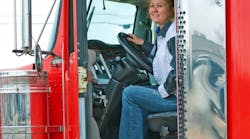How safe do female truck drivers feel on the job? According to a WIT [Women in Trucking] Best Practices Survey conducted by Sawgrass Logistics and The Women in Trucking Association, female truck drivers rated how safe they felt in their job a 4.4 on a scale of 1 to 10.
The survey, which takes a deeper dive into what attracts female drivers into the industry and what makes them leave, was discussed during a live, call-in radio show called Women In Trucking on SiriusXM Road Dog channel 146. The weekly, two-hour show premiered on Saturday, Jan. 20.
“Women are inherently more risk averse than men,” explained Keera Brooks, president and CEO of Sawgrass Logistics. “So when you look at all the areas of safety, or risk, that come with this career it becomes clearer why this is such a large issue for women drivers.”
Brooks added that the survey included all aspects of safety on the job – personal, while driving and stopped, weather, equipment, infrastructure, and other drivers on the road.
Women comprise only 7% of the workforce in trucking today. And with the industry experiencing an unprecedented truck driver shortage and a driver turnover rate that is the highest it’s been since 2015, many feel the industry needs to do better.
So when people ask Ellen Voie, president and CEO of The Women In Trucking Association (WIT), why there is a need for a Women In Trucking Association, her response is always: “If you’re happy with 7% female drivers and 14% of women in management, then you probably don’t think it’s important to encourage women to look at careers in this industry,” she told Fleet Owner. “But we aren’t satisfied with that.”
Voie recently started hosting the radio show, which airs every Saturday at 11 a.m. ET and addresses gender diversity issues in trucking and pushes for more women to join its ranks
The show features listener call-ins and interviews with professionals from the trucking industry – from drivers, technicians, and engineers to transportation CEOs and dispatchers. It also intends to help promote the employment of more women by identifying and removing the obstacles that keep them from entering the field.
When it comes to women entering the trucking industry, a vast majority of women – 83% – came into the industry because of a family member or friend. However, those same women haven’t recruited or recommended the industry to other women.
“Women feel that they’re not treated fairly,” Voie said, noting this is based on information coming from WIT members. “They feel that dispatchers treat them less fairly than their other male counterparts and that treatment by other men isn’t always the best.”
Brooks explained there is no silver bullet really when it comes to attracting drivers, particularly women, into the industry. But she did highlight some things that make it more difficult to recruit new female drivers – personal safety concerns, corporate culture at carriers, lack of women in existing roles, lack of referring women into the industry, and ongoing support and mentorship.
“It is critically important to look at this as a collective shift that must occur across the entire industry,” Brooks said. “Those who are at the forefront will have a competitive advantage over other companies resistant to change. Our industry needs to understand that this is not a quick fix that is easily solved with a marketing campaign. All areas of the driver lifecycle must be engaged in change in order to sustain long-term improvements and truly move the needle in increasing the percentage of women drivers.”
According to Brooks, here are some best practices carriers can follow:
- Recruiting/Marketing – Investigate efficacy of a driver referral program. Update website or marketing collateral with 50/50 split showing women in the role so they can visualize themselves there.
- CDL Training – Employ both male and female driver trainers. Go outside the industry to bring in more female trainers, increase online training to enable remote education when possible, and implement mentor program for students to establish support early on and increase confidence.
- New Hire Orientation – Do not automate post-orientation follow up through survey or third party – women want human connection. Enable more online orientation when possible to limit, and enable dependent care requirements (dependent care includes spouse and parent as well as children).
- Contributing Employee – Track employee satisfaction annually to measure and build action plans. Examine company culture to identify areas for improvement to create more inclusivity. Invest in terminal improvements aimed at increasing safety, bathroom availability, laundry and personal conveniences such as personal hygiene and beverages.
And use caution when offering sign-on bonuses. Though Sawgrass is a 3PL and doesn’t hire drivers directly, Brooks noted the company is aware that the industry is experiencing some of the highest driver turnover ever seen at around 90%. To mitigate the high turnover, carriers have been offering sign-on bonuses to recruit drivers, which Brooks said has led to unintended consequences “with respect to short-sighted behavior from drivers playing the market and following the money.”
“Signing bonuses are abundant and turnover remains high,” she explained. “After looking at the data from the best practices study, I believe investing in the employees you have today and shaping the corporate culture towards becoming more inclusive will drive higher employee satisfaction and lead to more employee referrals in an industry where 83% of drivers say they were introduced into trucking by a family member or friend.”




